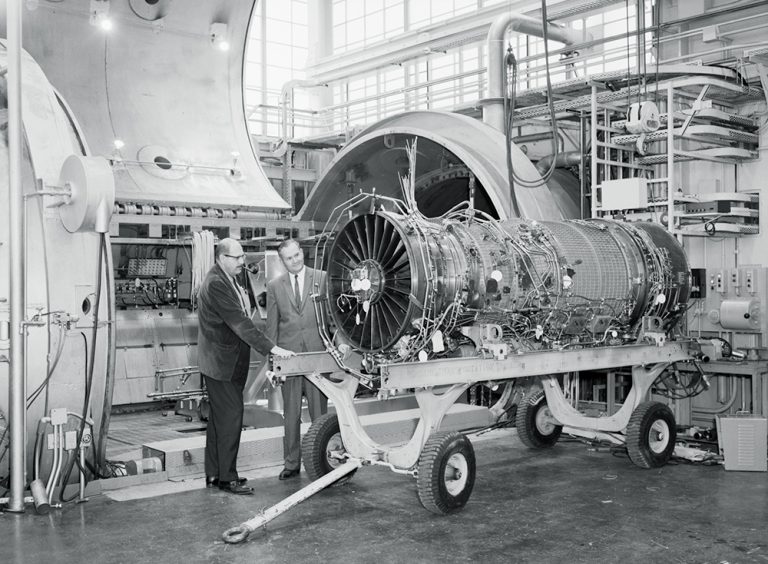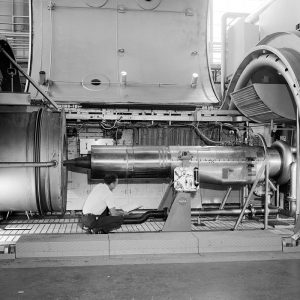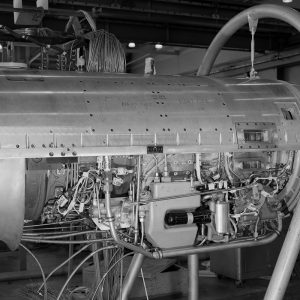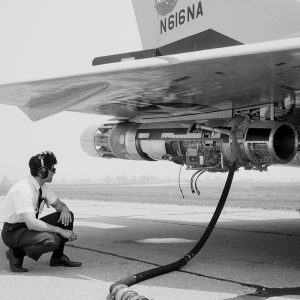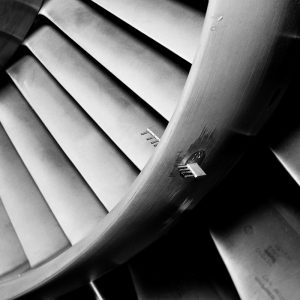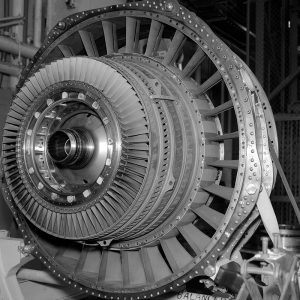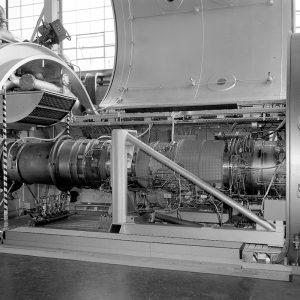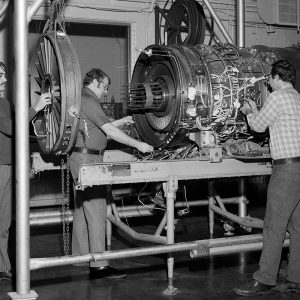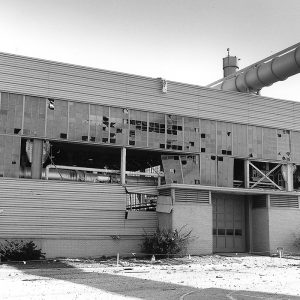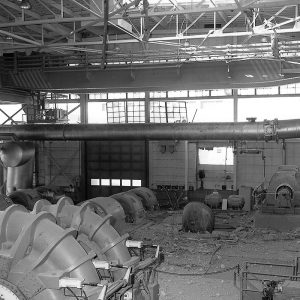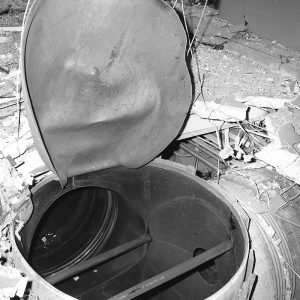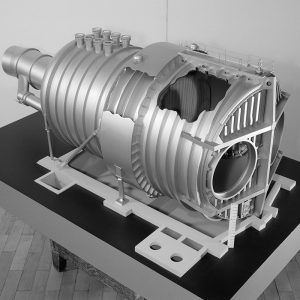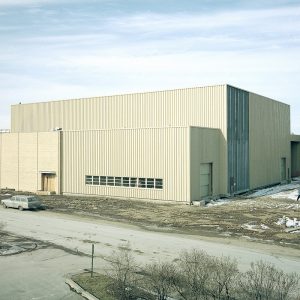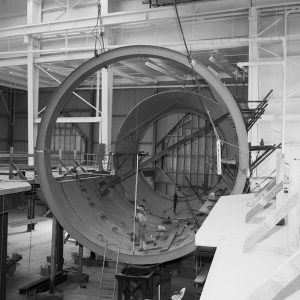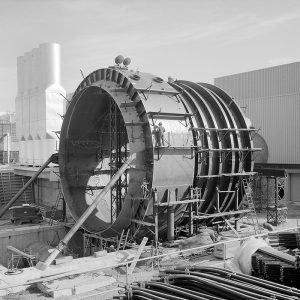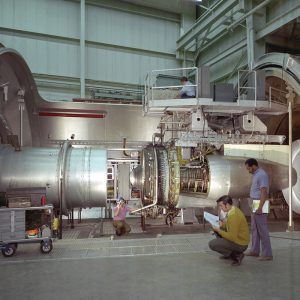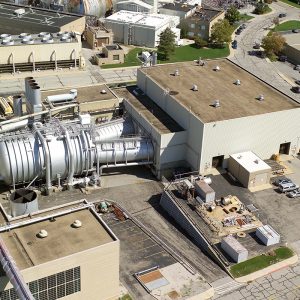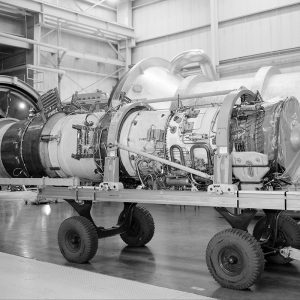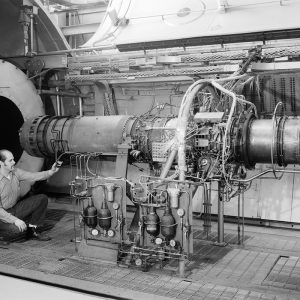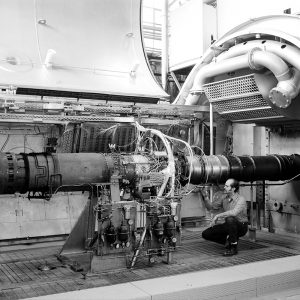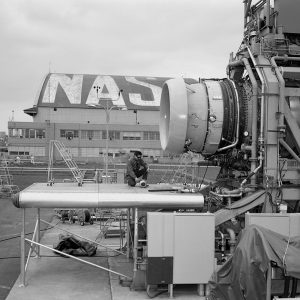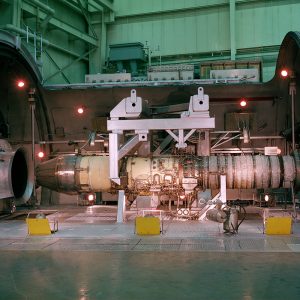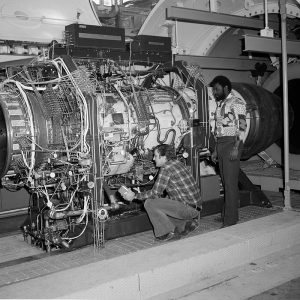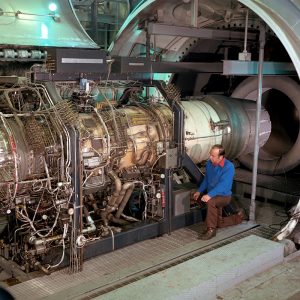Return to Jet Engines
In the late 1960s and 1970s, PSL undertook a series of engine studies for civilian and military aircraft. NASA also created two larger PSL test chambers to support the increased aeronautics work.
Overview
After nearly a decade of concentrating on rockets, the Lewis Research Center began returning to aircraft propulsion in 1966. During the interim, the jet engine took over the airline industry, and manufacturers were developing the next generation of the jet engine: the turbofan. The jumbo jet generation of airliners that emerged in the early 1970s was almost entirely powered by turbofan engines. Much of the work at PSL during the mid-1970s concentrated on making turbofan engines quieter and more efficient.
NASA Lewis instituted an Airbreathing Engine Division that used the Propulsion Systems Laboratory (PSL) No. 1 and 2 and other facilities to study the turbofans. The center also added two new test chambers with greater capabilities to the PSL complex. Unlike Lewis’ previous research, the majority of the new engine studies were for civilian aircraft and not the military.
Documents
Engine Calibration Study
In the late 1960s and early 1970s the center’s Airbreathing Engine Division sought to improve aircraft engine performance and fuel efficiency while reducing noise and emissions. In order to test the effect of experimentally modified engine components, NASA engineers first had to be able to determine the engine’s baseline performance characteristics. Lewis selected General Electric’s J85-13 as the workhorse engine to test experimental modifications. The J85-13’s modest speed and light weight made it appealing for the test program.
PSL was used to determine the correct nozzle inlet temperature and pressure and gas flow rate at transonic speeds. Using this data, NASA Lewis researchers were able to determine the engine’s gross thrust within a 0.06 percent error margin. These measurements could be the basis for future engine and nozzle tests in the PSL, on test aircraft, and in other facilities.
Documents
- Status of NASA Full-Scale Engine Aeroelasticity Research (1980)
- Characteristics of Aeroelastic Instabilities in Turbomachinery (1979)
- Inlet Temperature Distortion on the Stall Limits of J85-GE-13 (1974)
Gallery
Effects of Air Flow and Distortion
Pratt & Whitney developed the TF-30, the first 25,000-pound thrust turbofan, in the early 1960s for the McDonnell Douglas F4A Tomcat and the General Dynamics F-111. Unlike turbojets, turbofans send much of their intake air around the engine core to increase thrust and fuel efficiency. The lower pressures found at high altitudes and distortions in the air flow reduced the stability of the compressor in the early models.
NASA Lewis conducted a number of tests with TF30-P-1 and TF-30-P-2 engines in PSL No. 1 to examine this phenomenon. Researchers initially used screens and other devices to create the distortions, but determined that the use of nozzles to inject air into the stream was most effective and cost-efficient to simulate the distortions. Using this method, engineers in PSL were able map the engine’s likeliness to stall from various pulses or distortions. They found that the duration of a stall-inducing pulse was the inverse of its amplitude.
Documents
- Afterburner Equipped Turbofan with and Without Inlet Flow Distortion (1970)
- Inducing Controlled Steady-state and Dynamic Inlet Pressure Disturbances (1970)
- Air Jets as a Steady-State Inlet Flow Distortion Device (1970)
Gallery
Equipment Building Explosion
In the early morning hours of April 7, 1971, a massive explosion ripped through the floor of the PSL’s Equipment Building. The blast seriously injured two employees and caused major damage to the facility. During the confusion of the midnight shift change, a butterfly valve between the exhausters and the exhaust stack was left sealed. Although the crew quickly scrambled to depressurize the system, a 96-inch-diameter head ruptured below the floor. The 6-inch-thick concrete floor, I-beams, windows, and heavy equipment were damaged. A 30-foot-diameter hole was blown in the roof that was 35 feet above the floor. An Accident Review Board found that when the valve was sealed it caused the exhausters to operate like compressors. This action quickly over-pressurized the system. Several check valves were incorporated into the system afterwards and a Recertification Program was established.
Documents
- Equipment Building Explosion article (1971)
- 1971 Building 64 Explosion briefing (2005)
- Recertification Program article (1987)
Gallery
Addition of PSL No. 3 and 4
In 1968, twenty years after planning began for the original PSL test chambers, NASA Lewis began preparing to add two additional and more powerful test cells. The original chambers improved upon the Four Burner cells, and the new $14 million PSL No. 3 and 4 chambers improved upon PSL No. 1 and 2. The new chambers could test engines twice as powerful any then in existence. The center intended on closing PSL No. 1 and 2 when the new cells became operational, but the aeronautics program was busy enough that all four chambers remained active for a number of years.
The PSL No. 3 and 4 chambers, 40-feet long and 24 feet in diameter, were substantially larger than PSL No. 1 and 2. Unlike PSL No. 1 and 2, the two new chambers shared a common exhaust cooler which gave the new system a Y-shaped appearance. The center expanded the exhausters and compressors in the original Equipment Building and added new heater and refrigeration systems to accommodate the new facility’s requirements. In addition, three Pratt and Whitney J57 jet engines supplied hot combustion air to the new test chambers.
As the hot exhaust gas exited the test section, it passed through a 17-foot-diameter water duct and into the 50-foot-diameter primary cooler. As the air flows through the cooler its heat is transferred to the cooler’s 2700 water-filled tubes. This reduces the air temperature from 3000 to 600 °F. A spray cooler further reduces the temperature of the gases to 150 °F before they are recirculated to the Central Air Building.
Excavations for the new PSL building were completed by October 1967, and the shell of the building was completed a year later. In September 1968, work began on the new test chambers and associated infrastructure. Nearly 5000 tons of steel were used to build the new facility. The installation of the combustion air, cooling water, and electrical systems began in September 1970. Construction was completed in late 1972.
Documents
- PSL No. 3 and 4 website (2018)
- PSL No. 3-4 Construction articles (1967-70)
- Contract Let for PSL Expansion (1968)
- PSL No. 3-4 Operation article (1972)
- Propulsion Systems Lab No. 3-4 brochure (1991)
Gallery
Full-Scale Engine Research
In the mid-1970s, NASA Lewis and the Air Force collaborated on two broad programs that studied a variety of design problems on full-scale engines. The first, the Full-Scale Engine Research (FSER) program utilized surplus Air Force engines as test beds to study a variety of topics, including flutter, inlet distortion, and electronic controls. In the late 1970s engineers from the Airbreathing Engines Division’s Engine Research Branch studied the Pratt & Whitney F100 and the General Electric J85-21 extensively for the FSER program.
Researchers used the J85-21 turbojet, a 5000-pound thrust variant of the J85-13, for two series of investigations—internal compressor aerodynamics and mechanical instability or flutter. They focused on two types of stall flutter, choke flutter, and system-mode instability. Each of these variations of distortion was unique from the others. The researchers assembled a collection of data from each type of instability.
Documents
Gallery
Pratt & Whitney F-100
The Pratt & Whitney F-100 turbofan was the first engine analyzed for performance problems in the FSER program. Since the F-100 was similar to the TF30 recently studied in PSL No. 1, much of the test hardware that was purchased for the previous tests was adapted and used for the F-100. Nonetheless, PSL No.2 had to be renovated to accommodate the larger F-100.
The initial turbojet and turbofan engines used fixed-geometry components with fuel flow and nozzle areas as variables. The engines being developed in the 1970s, however, implemented variable-shaped compressor and fan blades. These new types of engines required greater control systems that could handle many parameters and additional variables while increasing the accuracy and response of the engine. One tool was the linear quadratic regulator. In 1975 the Air Force asked NASA Lewis to develop and test the multivariable control system on an F-100 engine. Lewis contracted with Systems Control, Inc. to devise a digital controller and perform initial computer simulation testing. In mid-1977 the system was installed on an F-100 and tested in PSL.
Documents
- F-100 Multivariable Control Synthesis Program (1983)
- Propulsion Controls, 1979
- Researchers Complete Tests of Control System article (1979)
- PSL MVCS Testing Correspondence (1975)

